Abstract
Homologous transfection systems provide a useful tool for characterizing promoters and other regulatory elements from cloned genes. We have used cultured Aedes albopictus C7–10 mosquito cells to evaluate expression of 20-hydroxyecdysone-inducible genes. Although this cell line has previously been shown to synthesize components of the ecdysteroid receptor and ecdysone-inducible proteins, the well-characterized ecdysteroid response element (EcRE) from the Drosophila hsp27 promoter failed to confer a substantial 20-hydroxyecdysone mediated induction in transfected mosquito cells. Recovery of stably transformed clones was also reduced in a DNA dependent manner when the EcREs were in the sense orientation, relative to control plasmids lacking the EcREs or containing an antisense construct. Finally, when tandem EcREs were placed within the hsp70 promoter, CAT activity was detected only after prolonged enzyme incubation, suggesting that the DNA interfered with cellular metabolism. In these constructs, we noted that the promoter DNA contained several potential binding sites for the activator protein-1 (AP-1) transcription factor, one of which lay between the tandem EcREs. On southwestern blots, a 40 kDa nuclear protein from C7–10 cells bound to DNA containing AP-1 sites. A DNA affinity column was used to partially purify the 40 kDa protein, and western analysis showed that the mosquito protein cross-reacted with a heterologous antibody to JUN. Likewise, mRNA from C7–10 cells cross-hybridized with the jun cDNA from Drosophila. These results suggest that like estrogen, 20-hydroxyecdysone interfaces with AP-1 as a co-activator protein that modulates the overall hormone response.
Keywords: Aedes albopictus, cell line, ecdysteroid receptor, EcRE
Introduction
Recent advances in mosquito transformation (Ito et al., 2002 and references therein) support the long-term possibility of controlling mosquito-borne diseases using transgenic approaches. In this context, it is envisioned that transgenic mosquitoes will be engineered to express multiple genes whose products will disrupt a pathogen at complementary and overlapping target sites. Success in this approach will ultimately require a sophisticated understanding of the normal processes that maintain pathogen life cycles in the adult female mosquito, as well as a diverse collection of cloned promoter elements and effector genes. Because pathogen acquisition and dissemination are achieved during blood feeding, genes that play a role in reproductive physiology may be particularly useful. Towards this end, Kakoza et al. (2000) have expressed the immunity protein defensin under the control of a promoter from the Aedes aegypti vitellogenin gene.
In Ae. aegypti, the steroid hormone 20-hydroxyecdysone (20E) plays a major role in adult reproduction. In the adult female fat body, expression of the vitellogenin gene is regulated by 20E, which is synthesized by the ovary in response to the blood meal. The genomic DNA sequence extending 2.1 kb upstream of the vitellogenin gene contains three distinct regulatory regions (Kokoza et al., 2001). The proximal region, from nucleotides −121 to −619 (relative to the transcription initiation site at +1), contains an ecdysteroid response element (EcRE) that has been shown to interact with the ecdysteroid receptor (EcR) and its heterodimeric partner, ultraspiracle (USP) in gel-shift assays. The medial region (−750 to −950) binds to E74 and E75 proteins, and a distal region contains several GATA sites. In aggregate, these motifs account for the high levels of vitellogenin expression in female fat body. In contrast, attempts to use the 2.1 kb fragment containing the vitellogenin EcRE in transfected cells have shown only modest levels of reporter gene activity in response to 20E (Martin et al., 2001), presumably due to the absence of tissue-specific transcription factors in cultured cells.
The best-defined EcREs are derived from genes that have been known since the 1980's to be induced by 20E in Drosophila cell lines (Echalier, 1997), rather than in the intact insect. Two inducible proteins: EIP28/29 and EIP 40, were identified in Kc cells within 4 h of 20E treatment (Cherbas and Cherbas, 1981; Cherbas et al., 1991). In parallel studies with Drosophila S3 cells, four small heat shock proteins, but not the larger heat shock proteins such as the well-known HSP70, were found to be 20E-inducible within 2 h of treatment (Ireland and Berger, 1982). The EcREs from the EIP28/29 and hsp27 genes have been extensively verified in transfection experiments, and in particular, the hsp27 EcRE was used to characterize in vitro binding of the Ae. aegypti EcR/USP heterodimer (Miura et al., 1999). Likewise, the Drosophila hsp 27 EcRE competitively inhibits receptor binding to the Ae. aegypti vitellogenin EcRE (Wang et al., 1998). In functional assays with mosquito cell lines, however, an endogenous mosquito EcRE that confers robust induction of a reporter gene at levels comparable to that from the hsp 27 promoter in transfected Drosophila cells (Dobens et al., 1991), remains to be described. The goal of the present study was to evaluate the D. melanogaster hsp27 EcRE in the 20E-responsive C7–10 cell line of the mosquito, Aedes albopictus, which expresses both EcR and USP (Jayachandran and Fallon, 2000, 2001) and synthesizes ecdysone-inducible proteins (Lan et al., 1993).
When a construct containing EcREs from hsp27 was stably transfected into mosquito cells, recovery of viable clones was reduced in proportion to the amount of DNA used for transfection. Nuclear extracts from C7–10 mosquito cells contained a 40 kDa protein that bound to DNA containing the EcRE, and gave a positive signal with antibody to the DNA binding domain of mouse JUN. Moreover, mRNA from C7–10 cells hybridized to a probe encoding Drosophila jun-related antigen (Perkins et al., 1990) under reduced stringency conditions. An interaction of Activator Protein −1 (AP-1) with the EcRE is consistent with data from vertebrate systems, which suggest that AP-1, together with hormone receptor proteins, may mediate a convergence of hormonal induction and signal transduction pathways at the transcriptional level (Gaub et al., 1990).
Materials and Methods
Cell lines and culture conditions
The Ae. albopictus (C7–10) mosquito cells were maintained in E-5 medium containing 5% fetal bovine serum essentially as described previously (Shih et al., 1998). Medium without serum is called E-0, medium with 5% serum is called E-5, and medium with 10% serum is called E-10.
Plasmid Construction and Transfection
The recombinant plasmids EcRE-2R-CAT, EcRE-2L-CAT and ptkATO were gifts from L. Dobens (Department of Biological Sciences, Dartmouth College), and their construction is described by Dobens et al. (1991). Probes of varying length were produced by digesting the SalI-XhoI, 206 bp fragment (pSX206) with BamHI and HpaII (pBH97), and with BamHI and BglII (pBBg184), where the subscript indicates nucleotide length. A second version of the EcRE-2R-CAT construct was produced from hsp-cat 1 (Di Nocera and Dawid, 1983) using a PCR-based strategy. Two tandem copies of a 23 bp EcRE from Drosophila hsp 27 and flanking sequence in the plasmid EcRE-2R-CAT (Dobens et al., 1991) were amplified by PCR using forward primer EcRE-1 and reverse primer EcRE-2 (Fig. 1). The PCR product was digested with XhoI and SalI to generate a 206 bp fragment, which was inserted into hsp-cat 1 at a unique XhoI site 195 nt upstream of the CAT transcription initiation site in hsp-cat 1. This plasmid was called hsp70-2R-CAT. The orientation of the insert was confirmed by PCR and by sequencing the final constructs. Plasmids of both orientations were used for transfection studies.
Figure 1.
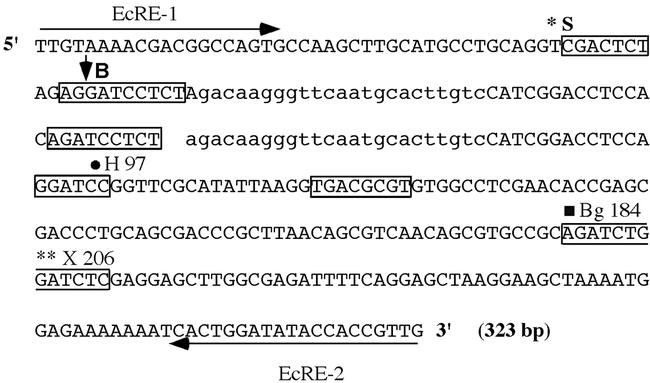
Sequence of the DNA fragment containing two tandem EcREs from the Drosophila hsp27 gene in EcRE-2R-CAT. Motifs resembling mammalian AP-1 binding sites are shown in boxes. Note that two contiguous sites are shown in the 3′-terminal box. The two tandem direct repeats of the 23 bp EcRE element in the 2R (sense) orientation (Dobens et al., 1991) are shown in lower case. Primers (EcRE-1 and EcRE-2) used to generate a fragment (termed EcRE) from EcRE-2R-CAT are shown by arrows. The resultant fragment was digested with SalI (*S) and XhoI (**X)to generate a 206 bp fragment that was cloned into hsp-cat 1 (DiNocera and Dawid, 1983; see Figure 2) and also used as probe for southwestern blotting. The downward-pointing arrow (BamHI) indicates the 5′-end of the shorter 97 and 184 bp probes; the 3′-ends of these smaller probes are identified by HpaII (H) and BglII (Bg) sites, respectively.
For transfection, plasmid DNAs were prepared by a single cycle of cesium chloride centrifugation (Fallon, 1989). The EcRE constructs were co-transfected with a selectable marker pDHFR9 (Shotkoski and Fallon, 1993) at a molar ratio of 1:1 with varying total DNA concentration using Lipofectamine (Invitrogen Life Technologies, http://www.invitrogen.com/) as the transfection agent. Transfections were carried out in Eagle's medium without serum (E-0) which was replaced by E-10, 8 h post-transfection. E-10 was replaced by E-5 24 h after transfection. Stably transfected cell clones were selected in 1 µM methotrexate (Shotkoski and Fallon, 1993) and maintained under selective conditions for subsequent experiments.
Isolation of Nuclei
Nuclei were obtained from C7–10 cells as described by Wu et al. (1979) with slight modifications. Cells were quick-chilled at −20°C for 1 min and centrifuged at 2500 rpm for 4 min at 4°C. The pellet was resuspended in 3 volumes of buffer A (60 mM KCl, 15 mM NaCl, 1 mM EDTA, 0.1 mM EGTA, 0.1 mM PMSF, 0.15 mM spermine, 0.15 mM spermidine, 15 mM Tris HCl (pH 7.4) and 0.25 M sucrose). The cells were lysed by addition of NP-40 to a final concentration of 0.25%, vortexed and checked under a microscope to confirm the lysis of cells and presence of intact nuclei. Two volumes of buffer B (60 mM KCl, 15 mM NaCl, 0.1 mM PMSF, 0.15 mM spermine, 0.15 mM spermidine, 15 mM Tris-HCl (pH 7.4), 0.5 mM DTT and 1.8 M sucrose) were added, and a nuclear pellet was recovered after centrifugation at 12,000 rpm for 15 min, using a swinging bucket rotor. The supernatant was aspirated and nuclear pellets were stored at −80°C until further use. Nuclear proteins were isolated and partially purified by heparin sepharose chromatography as described by Baldridge and Fallon (1996).
Partial Purification of the 40 kDa protein by size-fractionation
The partially purified nuclear extract (in 20 mM HEPES-NaOH, pH 7.9, 100 mM KCl, 5 mM MgCl2, 0.1 mM EDTA, 0.5 mM DTT, 0.5 mM PMSF, 20% glycerol supplemented with 1.0 M KCl) was processed using Microcon microconcentrators (Amicon, http://www.millipore.com/) following the manufacturer's instructions. Nuclear extracts were loaded onto a Microcon 50 and were spun at 4°C for 10 min to recover proteins with molecular weights lower than 50 kDa. The flow-through was loaded onto a Microcon Model 30 that had a molecular weight cut-off of 30 kDa.
DNA-Affinity Chromatography
DNA-affinity chromatography was essentially carried out using the protocol outlined by Ausubel et al. (1999) with slight modifications. The synthetic PAGE-purified oligonucleotide contained four tandem copies of the sequence 5′ CGA CTC TAG AGG ATC CTC CTA 3′ and its complement, with 5′-GATC overhangs (Kadonaga, 1991) to facilitate coupling of DNA to the CNBr-activated resin. The oligonucleotides (100 nM per ml) were annealed in the presence of 100 mM Tris-HCl, pH 7.5; 1 M NaCl and 10 mM EDTA by subjecting them to 65°C for 10 min and cooling slowly to room temperature over an hour in a thermal cycler. The annealed oligonucleotides were coupled to CNBr-activated sepharose (Sigma Aldrich, http://www.sigmaaldrich.com/) according to Ausubel et al. (1999). These steps were carried out in a fume hood and the affinity resin was stored at 4°C. The partially purified protein sample was then loaded onto the resin and washes were carried out as described in Ausubel et al. (1999). The sample was eluted and purity was evaluated by SDS-PAGE (Laemmli, 1970).
SDS-PAGE and southwestern blotting
Proteins were separated by standard 12% SDS-PAGE and stained with Coomassie Brilliant Blue. For southwestern blotting, proteins were electroblotted onto nitrocellulose membranes (Schleicher and Schuell, http://www.s-and-s.com/) for 90 minutes at 100 V in 25 mM Tris base, 192 mM glycine, 20% v/v methanol (pH 8.3). The blots were pre-incubated in 10 mM HEPES-KOH, pH 7.5, 5% non-fat powdered milk for 45 min followed by incubation in binding buffer (10 mM HEPES-KOH, pH 7.5, 10 mM MgCl2, 50 mM NaCl, 1 mM DTT, 0.1 mM EDTA) containing different sizes of EcRE DNA fragments for 1 h at 20°C. The DNA probes pSX206 (generated by digesting the EcRE fragment with SalI and XhoI), pBBg184 (EcRE digested with BamHI and BglII) were end-labeled with Klenow fragment. The blots were then washed with binding buffer three times (20 min each), air-dried and exposed to Kodak X-ray films (Baldridge and Fallon, 1996).
Western blotting
Proteins were blotted onto nitrocellulose and used for detecting the protein with a commercial mouse c-JUN antibody (generated against the conserved DNA binding domain) obtained from Santa Cruz Biotechnology Inc. (http://www.scbt.com/). The blotting procedure and subsequent development with alkaline phosphatase have been described (Jayachandran and Fallon, 2001).
Isolation of mRNA and Northern blotting
Messenger RNA was isolated from total RNA obtained from C7–10 cells using Oligotex mRNA midi kit (Qiagen, http://www.qiagen.com/). Northern blots were prepared as described previously (Jayachandran and Fallon, 2000), using ∼ 5 µg of mRNA loaded onto a 0.8% agarose gel. Low stringency hybridization (40% formamide, 5X SSC, 5X Denhardt's, 0.1% SDS and 150 µg/ml of salmon sperm DNA) was carried out at 37°C overnight. The membrane was washed at 42°C twice with 2X SSC/0.5% SDS and twice with 2X SSC/0.1% SDS. The membrane was exposed to X-ray film overnight. The probe used was a 1 kb PCR amplified cDNA insert from plasmid DJRA, encoding Drosophila Jun-Related Antigen. This plasmid was a gift from Dr. Robert Tjian, Department of Molecular and Cell Biology, Howard Hughes Medical Institute, University of California, Berkeley. The PCR product was labeled by random priming, using a kit from Amersham-Pharmacia (http://www.apbiotech.com/) as described previously (Jayachandran and Fallon, 2000).
Results
The hsp27 EcRE decreases recovery of transfected mosquito cells
We began these studies by investigating whether the EcRE-2R-CAT construct (Fig. 1) described by Dobens et al. (1991) was 20E-inducible in C7–10 Aedes albopictus mosquito cells. Because we were unable to replicate the robust 20E response previously noted in Drosophila S3 cells, we constructed a related plasmid, hsp70-2R-CAT, in which a PCR-generated fragment from EcRE-2R-CAT was inserted 195 nucleotides upstream of the CAT transcription initiation site in the sense (R) orientation (Fig. 2A). This plasmid showed modest heat-inducible CAT activity in the absence of 20E (Fig. 2B, compare lanes 1 and 2) but note that the enzyme incubation time was extended from 1 h used with hsp-cat 1 alone (Durbin and Fallon, 1985; Gerenday et al., 1989) to 12 h with the EcRE insert. Although low levels of induction may have occurred in the presence of 20E alone (compare lanes 1 and 3), 20E together with heat shock did not give the anticipated additive induction (compare lanes 3 and 4).
Figure 2.
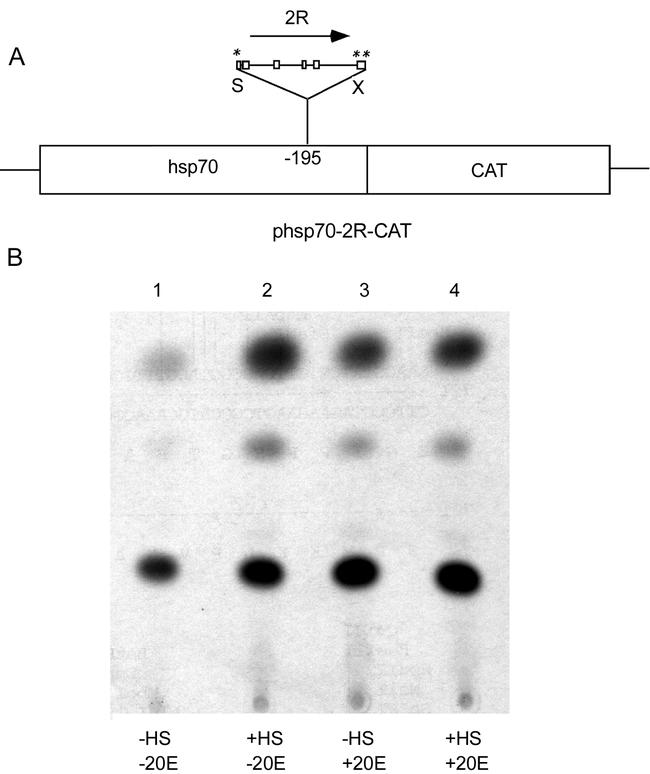
Schematic representation of phsp70-2R-CAT. Panel A: The parent plasmid hsp-cat 1 was digested at a unique XhoI site, 195 nucleotides upstream of the transcription start site of the CAT reporter gene. The insert labeled 2R was produced using primers EcRE-1 and EcRE-2 (Fig. 1), digested with SalI and XhoI, and ligated to the XhoI digested hsp-cat 1 plasmid. Panel B: Heat-shock inducible CAT activity from phsp70-2R-CAT. Cells were treated with 10−5M 20E, 24 h after transfection. Heat shock included a 4 h treatment at 41°C, followed by a 2 h recovery, immediately before the cells were harvested and lysed. The CAT assay was done as described previously (Durbin and Fallon, 1985), but the incubation time was extended to 12 h.
To address the possibility that the absence of a robust 20E induction reflected a detrimental effect of EcRE-containing constructs on cell viability, we co-transfected EcRE-2R-CAT with a second plasmid containing an Ae. albopictus dihydrofolate reductase gene as a selectable marker. Figure 3 shows the appearance of cells 48 h after transfection with 2 µg of EcRE-2R-CAT DNA. Stably transfected clones were selected in the presence of 1 µM methotrexate (Shotkoski and Fallon, 1993). Recovery of clones transfected with EcRE-2R-CAT plasmid was slower, and more sensitive to the amount of input DNA, relative to cells transfected with control plasmids that lacked EcREs (ptkAT0 in Table 1), or that contained EcREs in reverse orientation (EcRE-2L-CAT in Table 1). With EcRE-2R-CAT DNA, we recovered stably transfected clones only when the amount of input DNA was reduced below 70 ng per plate (Table 1 and Fig. 3). Transfection of control plasmids did not reduce recovery, even when the input DNA was 7 µg/plate.
Figure 3. (Left).
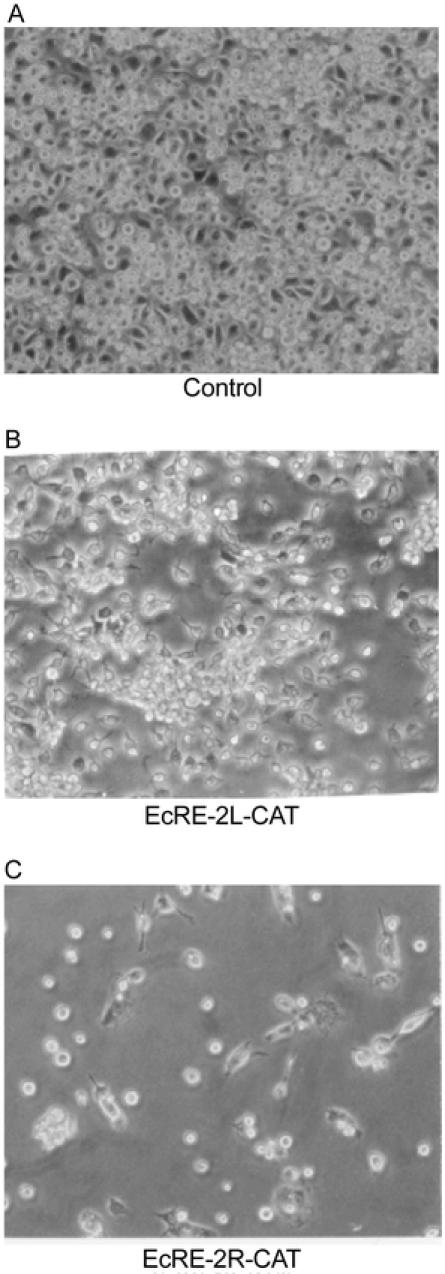
Effect of EcRE-2R-CAT on the growth and morphology of stably transfected C7–10 cells. Panel A shows untransfected control cells; Panel B shows cells transfected with EcRE-2L-CAT, in which the tandem pair of EcREs is in reverse orientation, relative to transcription of the CAT gene. Panel C shows C7–10 cells transfected with EcRE-2R-CAT. Cells were treated with 2 µg of DNA. The photographs show the appearance of cells 48 h after transfection, before addition of methotrexate (compare Table 1).
Table 1.
Aedes albopictus C7–10 cells, transfected with EcRE-2R-CAT constructs
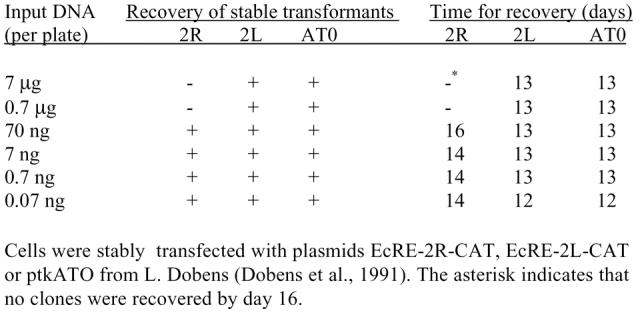
To explain this observation, we hypothesized that a protein essential to cell growth becomes limiting when EcREs are transfected in excess. This hypothesis was consistent with the findings of Dobens et al. (1991), who saw reduced CAT activity after transient transfection when the EcRE-2R-CAT construct was co-transfected with multiple copies of the EcRE sequence without an attached reporter gene. Thus, we envisioned that in C7–10 cells, high levels of a plasmid containing EcREs sequestered a protein that was essential to the survival and growth required for recovery of methotrexate-resistant clones.
The regulatory region from EcRE-2R-CAT contains AP-1 consensus sites
To explore the basis for reduced recovery of C7–10 cell clones after transfection with DNA containing EcREs in the sense orientation, we examined a 323 bp fragment containing the regulatory region from EcRE-2R-CAT for the presence DNA-binding motifs (Fig. 1). Aside from the two tandem EcREs, the DNA contained seven matches to the Activator Protein-1 (AP-1) consensus motif: TG(A/C)(C/G)(T/A)(C/A)A (underlined bases are the most commonly found) distributed over the entire 323 bp fragment. Two tandem AP-1 sites occur just upstream of the distal 23 bp synthetic EcRE, and 4 sites occur downstream of the second EcRE, relative to the transcription initiation site. A particularly good match to the AP-1 consensus was located between the EcREs. In the transfection experiments mentioned above, this site and the tandem EcREs would have been in reverse orientation in the control plasmid, EcRE-2L-CAT, which gave normal recovery of stably transfected clones.
A 40 kDa protein binds EcRE-2R-CAT DNA
In an electrophoretic mobility shift assay (Fig. 4A), the [32P] end-labeled 206 bp fragment (pSX206) was associated with two shifted bands (lane 2), which were efficiently competed by 50-fold excess unlabeled probe (Fig. 4A, lane 3). When the DNA probe (100 ng) was incubated with blots containing nuclear and cytoplasmic protein from C7–10 cells in a southwestern assay, pSX206 (data not shown), and a smaller 184 bp probe (pBBg184) containing four AP-1 consensus sites, bound to a ∼40 kDa protein in extracts from C7–10 cells. Binding was decreased with increased amounts of competitor DNA (Fig. 4B). Subcellular fractionation indicated that the ∼40 kDa protein is nuclear (Fig. 5). The weak band at 70 kDa is similar in size to the protein FOS, which binds to the 40 kDa JUN protein to form the AP-1 transcription factor. Alternatively, this band might represent a dimer of the 40 kDa protein. Consistent with the transfection studies described above, southwestern analysis with ptkATO and EcRE-2L-CAT failed to bind the 40 kDa protein.
Figure 4. (Above).
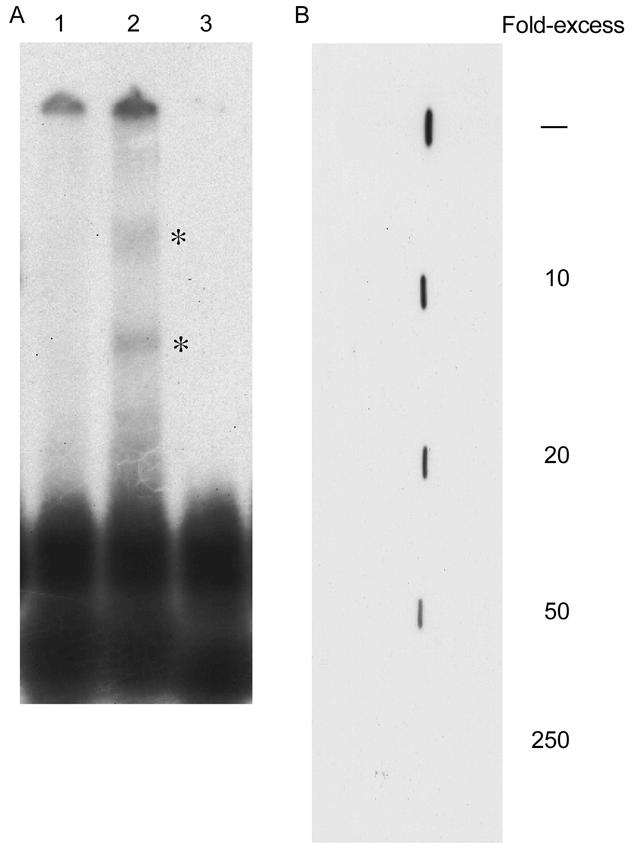
Binding of an EcRE fragment to protein. Panel A shows an electrophoretic mobility shift assay in which C7–10 nuclear extracts were incubated with end-labeled pSX206 DNA. Lane 1 shows migration of the probe in the absence of protein. Lane 2 contains nuclear protein from approximately 1 g of C7–10 cells, and Lane 3 contains nuclear protein and ∼500 fold excess non- radioactive probe. Panel B shows a southwestern blot in which end-labeled pBBg184 DNA was incubated in the presence of 0 to 250-fold excess unlabeled DNA on individual nitrocellulose strips.
Figure 5.
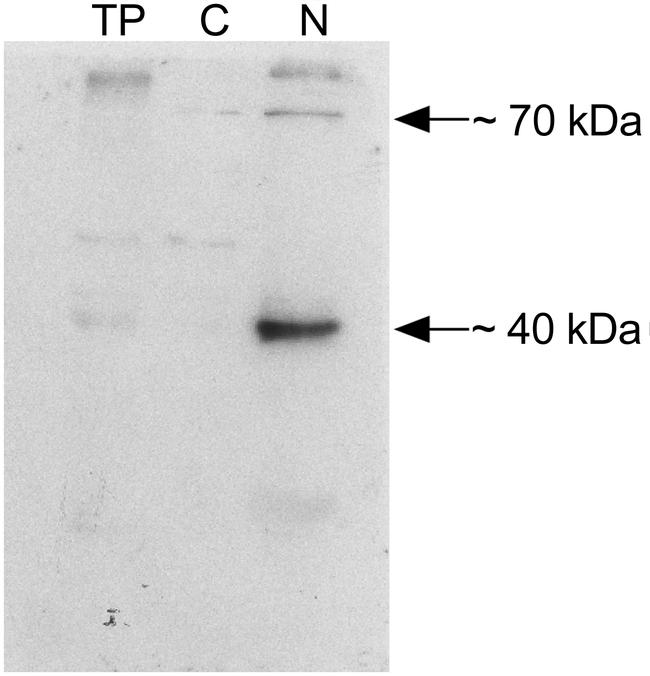
Subcellular localization of the 40 kDa protein in C7–10 Aedes albopictus mosquito cells. All lanes contain ∼20 µg of protein. Lane 1 is total protein (TP), lane 2 is the cytoplasmic (C) fraction and lane 3 is the nuclear (N) fraction. The probe was end-labeled pSX206.
The 40 kDa protein is recognized by an antibody to JUN
Finally, we prepared a large batch of nuclear extract, bound the protein to heparin-sepharose, and recovered the 40 kDa protein by elution with 1 M KCl (Fig. 6A). The eluate was size fractionated, and the 30 to 50 kDa fraction (Fig. 6B, lane 4) was passed over a DNA affinity column (Ausubel et al., 1999; Kadonaga, 1991) containing four tandem copies of 5′CGACTCTAGAGGATCCTCTA (underlined bases indicate AP-1 motifs) and its complement. When the eluate was examined on SDS gels, it contained a single prominent band measuring ∼40 kDa (Fig. 6C). On western blots (Fig. 7A), the purified protein gave a clear signal with commercial antibody to the mouse JUN protein.
Figure 6.
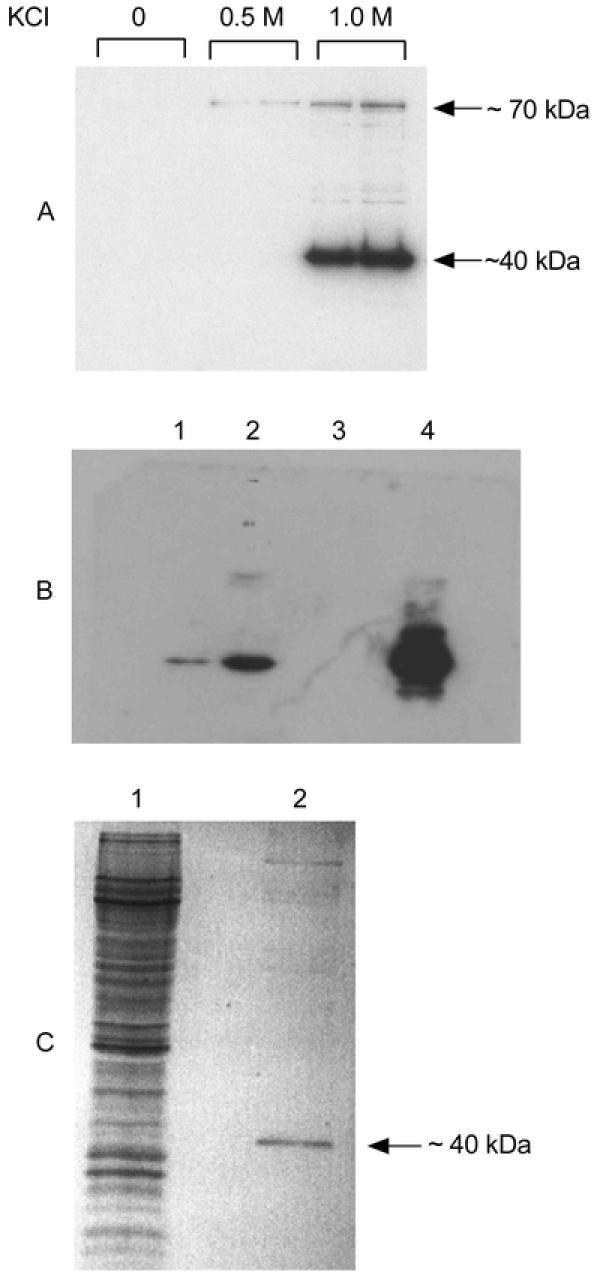
Purification of the the 40 kDa protein. Panel A represents a salt elution of the ∼40 kDa protein from Heparin-sepharose as described by Baldridge and Fallon (1996). Values at top represent KCl concentrations. A southwestern blot is shown. Panel B shows enrichment of the 40 kDa protein by size fractionation and analysis by southwestern blotting. All lanes contain ∼10 µg nuclear protein. Lane 1 is total nuclear protein; lane 2 shows protein that passed through a 50kDa filter; lane 3 shows nuclear proteins that passed through a 30 kDa filter, and lane 4 contains proteins between 30–50 kDa. Panel C. SDS-PAGE of the nuclear lysate (starting material, lane 1) and purified protein from Panel B, lane 4 (lane 2). The gel was stained with Coomassie blue.
Figure 7A.
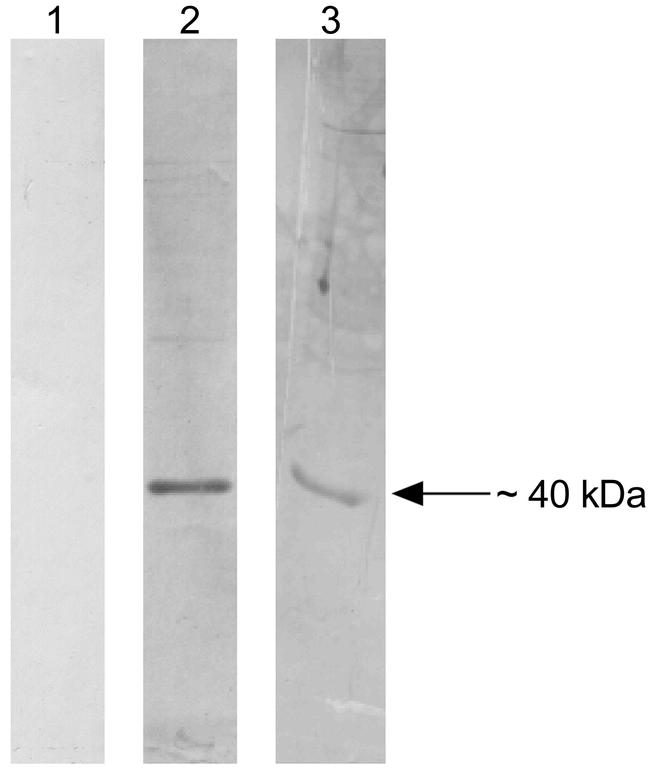
Western blot of the 40 kDa mosquito protein using a commercially available rabbit polyclonal c-JUN primary antibody (epitope corresponding to the highly conserved DNA binding domain of mouse) from Santa Cruz Biotechnology Inc. (Santa Cruz, CA) known to be mouse, rat, chicken and human reactive. Lane 1 is the negative control without the primary antibody. Lane 2 shows ∼ 2 µg of purified protein, and lane 3 contains 25 µg of nuclear protein lysate. Primary antibody was used at a dilution of 1: 1000. The secondary antibody (goat anti-rabbit IgG tagged with alkaline phosphatase) was obtained along with the development kit from Biorad Laboratories (Hercules, CA).
Detection of mosquito jun on northern blots
An alternative approach to obtaining the mosquito JUN-like protein was based on detecting the mosquito jun cDNA. When northern blots were probed at low stringency (40% formamide, 37°C) with a PCR-generated probe from Drosophila jun cDNA, we detected a single band (Fig. 7B), in lanes containing 5 µg of polyadenlyated mRNA. No signal was detected with total RNA.
Figure 7B.
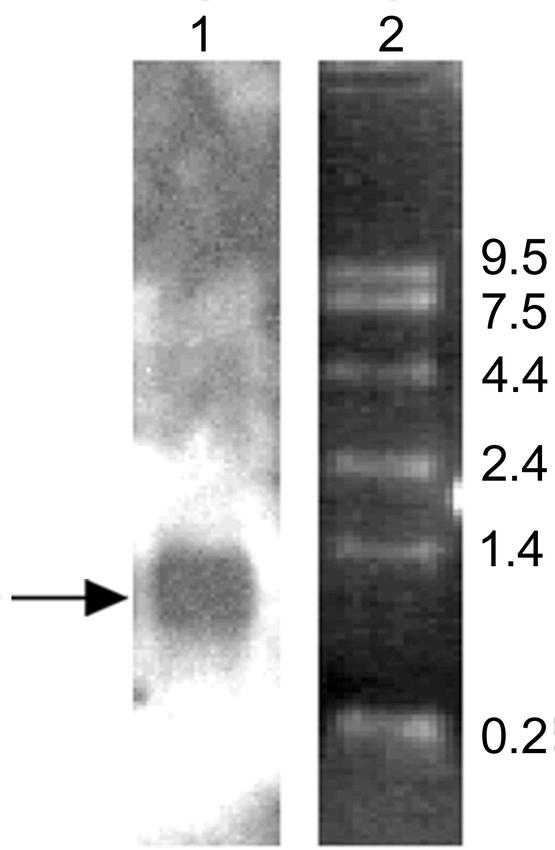
Northern analysis of C-710 mRNA with Drosophila jun cDNA probe. C7–10 mRNA (5 µg) was loaded onto a 1 % denaturing agarose gel. Both hybridization and washing were carried out under low stringency conditions as described in Materials and Methods. The arrow in lane 1 indicates hybridization signal; lane 2 shows size markers.
Discussion
Based on the ability to confer 20E-inducible expression of a reporter gene in transfected cells, the most efficient, and best characterized EcRE is that which occurs upstream of the Drosophila hsp27 gene. This EcRE sequence, 5′-GGTTCAaTGCACT, which has a single nucleotide (lower case “a”) separating two imperfect inverted repeats, is called IRhsp-1 (IR for inverted repeat; hsp for heat shock protein; and 1 for the single nucleotide spacer). Although most of the natural EcREs that have been defined in Drosophila are imperfect inverted palindromes, considerable variation in EcRE sequence has been described (Cherbas and Cherbas, 1996). Likewise, based on electrophoretic mobility shift assays, Raikhel and coworkers predicted that the Aedes EcR/USP heterodimer can bind a variety of DNA motifs, and that these motifs can be oriented as direct or inverted repeats (Wang et al., 1998).
In addition to binding to the EcR/USP heterodimer, EcREs are characterized by their ability to confer 20E-inducible activity on a reporter gene. In functional assays in Drosophila cells, for example, the hsp27 EcRE shows stronger activity than other EcREs, and oligomers based on the hsp27 EcRE can generate induction ratios as high as 500-fold (Cherbas and Cherbas, 1996). Although D. melanogaster EcRE consensus sequences are often used to define putative EcREs in genes from insects other than Drosophila, it should be noted that most of the elements defined for mosquito genes, such as the prophenoloxidase 1 gene in an Anopheles gambiae cell line (Ahmed et al, 1999), have not been examined using functional assays. Moreover, homologous mosquito and Drosophila EcREs from the same gene, which might be used for direct comparison, are not yet available. Finally, although the EcREs and heat shock response elements are distinct and non-overlapping (Hoffman and Corces, 1986), we note that endogenous small heat shock proteins are not 20E-inducible in C7–10 cells (Lan et al., 1993).
Our recent attempts to elicit 20E-inducible CAT expression have included treatment of transiently or stably-transfected cells with 10−9, 10−8, 10−7 or 10−6 M 20E. Double-treatments wherein 10−8 M was followed by 10−6 M 20E also did not show any induction of reporter gene expression in cells collected 6, 12, 24, 48 and 72 h after 20E treatment. Similar results were obtained with an alternative CAT plasmid, in which DNA containing the EcRE-2R element was inserted upstream of the CAT gene in the hsp-CAT-1 plasmid of Di Nocera and Dawid (1983) as described in the Materials and Methods. Detection of CAT activity required an extended incubation of cell lysates with substrate, and RT-PCR showed uniform expression of the CAT gene irrespective of 20-E treatment. Ecdysone treatments were also done in medium containing steroid-free serum (Lan et al., 1993) and in steroid-free medium from which phenol red, which has been shown to have estrogenic properties (Berthois et al., 1986), was omitted. Aside from these efforts, we note that relatively little attention has been given to the characterization of mosquito EcREs in transfected mosquito cells or exploring whether other insect cell lines in general can reproduce the robust 20E induction that has been described with Drosophila cells using either Drosophila or species-specific EcREs. However, Lan et al. (1999) have characterized four putative EcREs in the MHR3 promoter in transfected Manduca sexta GV1 cells and their responsiveness to 20E.
A trivial explanation for the lack of a robust 20E-inducible response lay in the possibility that C7–10 cells fail to express the EcR and USP components of the receptor. However, we have detected both EcR and USP transcripts in the C7–10 cell line (Jayachandran and Fallon, 2000), consistent with our earlier description of 20E-inducible proteins (Lan et al., 1993). Endogenous mosquito genes, such as the vitellogenin gene from Ae. aegypti, contain EcREs (Martin et al., 2001) that have been tested in transfected Drosophila S2 cells, but 20E inducible expression was typically less than 3-fold, relative to solvent-treated control cells. In contrast, Dobens et al (1991) showed on the order of 20-fold induction of reporter gene activity in cells transfected with the two tandem hsp27 EcREs in the plasmid EcRE-2R-CAT after treatment with 20E. In transfected mosquito cells, a response of this magnitude has not yet been reported with either Drosophila EcREs or with putative mosquito EcREs.
In contrast, our efforts to express 20E-inducible constructs in transfected mosquito cells support the hypothesis that interference with the 20E pathway involving either the EcR itself (Jayachandran and Fallon, 2001) or the EcRE has a negative effect on cell growth, survival, and recovery of stably transformed clones. The present studies suggest that cell metabolism may be disrupted by the interaction of a 40 kDa, nuclear protein with AP-1 sites in the vicinity of the EcREs. The AP-1 (mammalian Activator Protein 1; Lee et al., 1987) transcription factor is comprised of proto-oncogene products JUN and FOS, which interact to form a JUN/JUN homodimer or a JUN/FOS heterodimer. The improved recovery of transformed cells when input DNA levels were reduced suggests that transfected DNA may acts as a sink that sequesters AP-1, leaving insufficient protein available for other essential functions.
The size and binding specificity of the 40 kDa protein were consistent with the properties of mammalian JUN, and a Drosophila jun cDNA probe detected a band on blots containing polyadenlyated RNA. Based on these promising results, we attempted to verify the identity of the protein by MALDI-TOF and tandem mass spectrometry (Kinter and Sherman, 2000), but have been unable to recover an acceptable match to available databases. The absence of a match in the databases may simply mean that the protein is novel, or that the mosquito protein has diverged considerably from its Drosophila homolog. In this connection, we note that the HHMI Biopolymer/Keck Facility at Yale University (http://info.med.yale.edu/wmkeck/prochem.htm#mspi) describes a success rate of 43% for their Manual MS Protein Identification Service with samples from species whose genome has not been sequenced. In an alternative approach, we have attempted to obtain the mosquito cDNA by RT-PCR, thus far without success. We note that the only insect homolog to mammalian JUN is that from D. melanogaster (Gb_in2:Dmu73196), and the closest match (43% identity) to the Drosophila jun is that from humans (Gb_pr2:Hsu65928). Alignment of the Drosophila and human sequences failed to uncover stretches of similarity that might be used to improve our design of PCR-primers.
JUN and FOS-related proteins have been characterized in D. melanogaster and have been shown to share functional homology with mammalian AP-1 (Perkins et al., 1988). Moreover in Drosophila, the JUN-related antigen appears to be uniformly expressed in at a low level in all cell types (Perkins et al., 1990). Although an interaction between JUN and an EcRE remains to be described in Drosophila, we note that the estrogen receptor has been shown to interact physically with JUN proteins (Teyssier et al., 2001), and that AP-1 has been broadly implicated in the integration of a variety of hormone-mediated responses (Uht et al., 1997).
Acknowledgments
This work was supported by grant AI 43791 from the National Institutes of Health, Bethesda, Maryland, and by the University of Minnesota Agricultural Experiment Station, St. Paul, Minnesota.
Glossary
| Abbreviation: | |
|---|---|
| 20E | 20-hydroxyecdysone |
| AP-1 | Activator Protein-1 |
| CAT | Chloramphenicol Acetyl Transferase |
| EcR | ecdysteroid receptor |
| EcRE | ecdysteroid response element |
| FOS | a proto-oncogene |
| JUN | a proto-oncogene |
| USP | ultraspiracle |
References
- Ahmed A, Martin D, Manetti AG, Han SJ, Lee WJ, Mathiopoulos KD, Muller HM, Kafatos FC, Raikhel A, Brey PT. Genomic structure and ecdysone regulation of the prophenoloxidase 1 gene in the malaria vector Anopheles gambiae. Proceedings of the National Academy of Sciences USA. 1999;96:14795–14800. doi: 10.1073/pnas.96.26.14795. [DOI] [PMC free article] [PubMed] [Google Scholar]
- Ausubel FM, Brent R, Kingston RE, Mooer DD, Seidman JG, Smith JA, and Struhl K. 1999 DNA-Protein interactions. In: Ausubel FM, Brent R, Kingston RE, Mooer DD, Seidman JG, Smith JA, Struhl K, editors. Short Protocols in Molecular Biology. 12:1–45.New York: John Wiley & Sons. [Google Scholar]
- Baldridge GD, Fallon AM. Evidence for a DNA homologous pairing activity in nuclear extracts from mosquito cells. Insect Biochemistry and Molecular Biology. 1996;26:667–676. doi: 10.1016/s0965-1748(96)00017-3. [DOI] [PubMed] [Google Scholar]
- Berthois Y, Katzenellenbogen JA, Katzenellenbogen BS. Phenol red in tissue culture media is a weak estrogen: Implications concerning the study of estrogen-responsive cells in culture. Proceedings of the National Academy of Sciences USA. 1986;83:2496–2500. doi: 10.1073/pnas.83.8.2496. [DOI] [PMC free article] [PubMed] [Google Scholar]
- Cherbas L, Cherbas P. The effects of ecdysteroid hormones on Drosophila melanogaster cell lines. Advances in Cell Culture. 1981;1:91–124. [Google Scholar]
- Cherbas P, Cherbas L. 1996 Molecular aspects of ecdysteroid hormone action. In: Gilbert, LI, Tata, JR, Atkinson, BG, editors. Metamorphosis: Postembryonic reprogramming of gene expression in amphibian and insect cells. 175–221.New York: Academic Press. [Google Scholar]
- Cherbas L, Schulz RA, Koehler MM, Savakis C, Cherbas P. Structure of the Eip28/29 gene, an ecdysone-inducible gene from Drosophila. Journal of Molecular Biology. 1986;189:617–631. doi: 10.1016/0022-2836(86)90492-4. [DOI] [PubMed] [Google Scholar]
- Cherbas L, Lee K, Cherbas P. Identification of ecdysone response elements by analysis of the Drosophila Eip28/29 gene. Genes and Development. 1991;5:120–131. doi: 10.1101/gad.5.1.120. [DOI] [PubMed] [Google Scholar]
- Di Nocera PP, Dawid IB. Transient expression of genes introduced into cultured cells of Drosophila. Proceedings of the National Academy of Sciences USA. 1983;80:7095–7098. doi: 10.1073/pnas.80.23.7095. [DOI] [PMC free article] [PubMed] [Google Scholar]
- Dobens L, Rudolph K, Berger EM. Ecdysterone regulatory elements function as both transcriptional activators and repressors. Molecular and Cellular Biology. 1991;11:1846–53. doi: 10.1128/mcb.11.4.1846. [DOI] [PMC free article] [PubMed] [Google Scholar]
- Durbin JE, Fallon AM. Transient expression of the chloramphenicol acetyltransferase gene in cutured mosquito cells. Gene. 1985;36:173–178. doi: 10.1016/0378-1119(85)90082-4. [DOI] [PubMed] [Google Scholar]
- Echalier G. 1997 Drosophila cells in culture. New York, Academic Press. 702. pp. [Google Scholar]
- Fallon AM. Optimization of gene transfer in cultured insect cells. Journal of Tissue Culture Methods. 1989;12:1–6. [Google Scholar]
- Gaub MP, Bellard M, Schuer I, Chambon P, Sassone-Corsi P. Activation of the ovalbumin gene by the estrogen receptor involves the fos-jun complex. Cell. 1990;63:1267–1276. doi: 10.1016/0092-8674(90)90422-b. [DOI] [PubMed] [Google Scholar]
- Gerenday A, Park Y-J, Lan Q, Fallon AM. Expression of a heat-inducible gene in trasnfected mosquito cells. Insect Biochemistry. 1989;19:679–686. [Google Scholar]
- Hoffman EP, Corces VG. Sequences involved in temperature and ecdysterone-induced transcription are located in separate regions of a Drosophila melanogaster heat shock protein gene. Molecular and Cellular Biology. 1986;6:6663–6673. doi: 10.1128/mcb.6.2.663. [DOI] [PMC free article] [PubMed] [Google Scholar]
- Ireland RC, Berger EM. Synthesis of low molecular weight heat shock peptides stimulated by ecdysterone in a cultured Drosophila cell line. Proceedings of the National Academy of Sciences USA. 1982;79:855–859. doi: 10.1073/pnas.79.3.855. [DOI] [PMC free article] [PubMed] [Google Scholar]
- Ito J, Ghosh A, Moreira LA, Wimmer EA, Jacobs-Lorena M. Transgenic anopheline mosquitoes impaired in transmission of a malaria parasite. Nature. 2002;417:452–455. doi: 10.1038/417452a. [DOI] [PubMed] [Google Scholar]
- Jayachandran G, Fallon AM. Evidence for expression of EcR and USP components of the 20-hydroxyecdysone receptor by a mosquito cell line. Archives of Insect Biochemistry and Physiology. 2000;43:87–96. doi: 10.1002/(SICI)1520-6327(200002)43:2<87::AID-ARCH5>3.0.CO;2-0. [DOI] [PubMed] [Google Scholar]
- Jayachandran G, Fallon AM. Antisense expression of the 20-hydroxyecdysone receptor (EcR) in transfected mosquito cells uncovers a new EcR isoform that varies at the C-terminal end. In Vitro Cell and Developmental Biology Animal. 2001;37:522–529. doi: 10.1290/1071-2690(2001)037<0522:aeothr>2.0.co;2. [DOI] [PubMed] [Google Scholar]
- Kadonaga JT. Purification of sequence-specific binding proteins by DNA affinity chromatography. Methods in Enzymology. 1991;208:10–23. doi: 10.1016/0076-6879(91)08004-2. [DOI] [PubMed] [Google Scholar]
- Kakoza V, Ahmed A, Wimmer EA, Raikhel AS. Engineering blood-meal activated systemic immunity in the yellow fever mosquito, Aedes aegypti. Proceedings of the National Academy of Sciences USA. 2000;97:9144–9149. doi: 10.1073/pnas.160258197. [DOI] [PMC free article] [PubMed] [Google Scholar]
- Kokoza VA, Martin D, Mienaltowski MJ, Ahmed A, Morton CM, Raikhel AS. Transcriptional regulation of the mosquito vitellogenin gene via a blood-meal triggered cascade. Gene. 2001;274:47–65. doi: 10.1016/s0378-1119(01)00602-3. [DOI] [PubMed] [Google Scholar]
- Kinter M, Sherman NE. 2000 Protein sequencing and identification using tandem mass spectrometry. New York, Wiley-Interscience, pp. 153–157. [Google Scholar]
- Laemmli UK. Cleavage of structural proteins during the assembly of the head of bacteriophage T4. Nature. 1970;227:680–685. doi: 10.1038/227680a0. [DOI] [PubMed] [Google Scholar]
- Lan Q, Gerenday A, Fallon AM. Cultured Aedes albopictus mosquito cells synthesize hormone-inducible proteins. In Vitro Cell and Developmental Biology Animal. 1993;29A:813–818. doi: 10.1007/BF02634349. [DOI] [PubMed] [Google Scholar]
- Lan Q, Hiruma K, Hu X, Jindra M, Riddiford LM. Activation of a delayed-early gene encoding MHR3 by the ecdysone receptor heterodimer. EcR-B1-USP-1 but not by EcR-B1-USP-2. Molecular and Cellular Biology. 1999;19:4897–906. doi: 10.1128/mcb.19.7.4897. [DOI] [PMC free article] [PubMed] [Google Scholar]
- Lee W, Mitchell P, Tjian R. Purified transcription factor AP-1 interacts with TPA-inducible enhancer elements. Cell. 1987;49:741–752. doi: 10.1016/0092-8674(87)90612-x. [DOI] [PubMed] [Google Scholar]
- Martin D, Wang SF, Raikhel AS. The vitellogenin gene of the mosquito Aedes aegypti is a direct target of ecdysteroid receptor. Molecular and Cellular Endocrinology. 2001;173:75–86. doi: 10.1016/s0303-7207(00)00413-5. [DOI] [PubMed] [Google Scholar]
- Miura K, Wang S-F, Raikhel AS. Two distinct subpopulations of ecdysone receptor complex in the female mosquito during vitellogenesis. Molecular and Cellular Endocrinology. 1999;156:111–120. doi: 10.1016/s0303-7207(99)00136-7. [DOI] [PubMed] [Google Scholar]
- Perkins KK, Dailey GM, Tjian R. Novel Jun- and Fos-related proteins in Drosophila are functionally homologous to enhancer factor AP-1. EMBO J. 1988;7:4265–4273. doi: 10.1002/j.1460-2075.1988.tb03324.x. [DOI] [PMC free article] [PubMed] [Google Scholar]
- Perkins KK, Admon A, Patel N, Tjian R. The Drosophila Fos-related AP-1 protein is a developmentally regulated transcription factor. Genes and Development. 1990;4:822–834. doi: 10.1101/gad.4.5.822. [DOI] [PubMed] [Google Scholar]
- Shih KM, Gerenday A, Fallon AM. Culture of mosquito cells in Eagle's medium. In Vitro Cell and Developmental Biology Animal. 1998;34:629–630. doi: 10.1007/s11626-996-0010-1. [DOI] [PubMed] [Google Scholar]
- Shotkoski FA, Fallon AM. The mosquito dihydrofolate reductase gene functions as a dominant selectable marker in transfected cells. Insect Biochemistry Molecular Biology. 1993;23:883–893. doi: 10.1016/0965-1748(93)90105-2. [DOI] [PubMed] [Google Scholar]
- Teyssier C, Belguise K, Galtier F, Chalbos D. Characterization of the physical interaction between estrogen receptor and JUN proteins. Journal of Biological Chemistry. 2001;276:36361–36369. doi: 10.1074/jbc.M101806200. [DOI] [PubMed] [Google Scholar]
- Uht RM, Anderson CM, Webb P, Kushner PJ. Transcriptional activities of estrogen and glucocorticoid receptors are functionally integrated at the AP-1 response element. Endocrinology. 1997;138:2900–2908. doi: 10.1210/endo.138.7.5244. [DOI] [PubMed] [Google Scholar]
- Wang SF, Miura K, Miksicek RJ, Segraves WA, Raikhel AS. DNA binding and transactivation characteristics of the mosquito ecdysone receptor-Ultraspiracle complex. Journal of Biological Chemistry. 1998;273:27531–27540. doi: 10.1074/jbc.273.42.27531. [DOI] [PubMed] [Google Scholar]
- Wu C, Bingham PM, Livak KJ, Holmgren R, Elgin SC. The chromatin structure of specific genes: I. Evidence for higher order domains of defined DNA sequence. Cell. 1979;16:797–806. doi: 10.1016/0092-8674(79)90095-3. [DOI] [PubMed] [Google Scholar]


